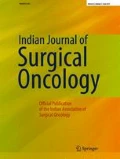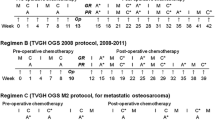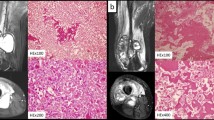Abstract
Although recent multimodality therapeutic protocols have led to improved survival in osteosarcoma (OS), the outcome still remains dismal. Ongoing international multicentric trials on OS aim to randomize patients for optimum management, based on histological response to NACT. The pathologic response to neoadjuvant chemotherapy (NACT) is the most important factor predicting prognosis. In this study of 23 cases of limb salvage surgery post neoadjuvant chemotherapy, mean age was 18.3 years, with male predominance. 65.5 % cases were conventional OS. Histologic assessment of chemotherapeutic effect done by Huvos grading revealed good response (Huvos lll and lV) in 15 (65.2 %) and poor response (Huvos l and ll) in eight (34.8 %). A scoring based on MRI with a scale of 1–6 was compared with histologic response. Five (62.5 %) of poor responders showed score of >3 and 73.3 % of good responders showed ≤3. Dose intensity of NACT was calculated and correlated with the histological response. 53.3 % of good responders showed ARDI > 0.9. Five (21.7 %) developed local recurrence and 10(43.4 %) had pulmonary metastasis. Adoption of more aggressive treatment modalities may ensure better histologic response and longer event free survival.






Similar content being viewed by others
References
Bacci G, Briccoli A, Rocca M (2003) Neoadjuvant chemotherapy for osteosarcoma of the extremities with metastases at presentation: recent experience at the Rizzoli Institute in 57 patients treated with cisplatin, doxorubicin, and a high dose of methotrexate and ifosfamide. Ann Oncol 14(7):1126–1134
Bacci G, Longhi A, Versari M (2006) Prognostic factors for osteosarcoma of the extremity treated with neoadjuvant chemotherapy15-year experience in 789 patients treated at a single institution. Cancer 106:1154–1161
Bajpai J, Gamnagatti S, Kumar R (2011) Role of MRI in osteosarcoma for evaluation and prediction of chemotherapy response: correlation with histological necrosis. Pediatr Radiol 41(4):441–450
Carrle D, Bielack SS (2006) Current strategies of chemotherapy in osteosarcoma. International Orthopaedics (SICOT) 30:445–451
Chen Y, Yang Y, Yuan Z (2012) Predicting chemosensitivity in osteosarcoma prior to chemotherapy: an investigational study of biomarkers with immunohistochemistry. Oncol lett 3(5):1011–1016
Coffin CM, Lowichik A, Zhou H (2005) Treatment effects in pediatric soft tissue and bone tumors. Practical considerations for the pathologist. Am J Clin Pathol 123:75–90
Davis AM, Bell RS, Goodwin PJ (1994) Prognostic factors in osteosarcoma: a critical review. J Clin Oncol 12(2):423–431
DeVita VT, Lawrence TS, Rosenberg SA (2008) Hellman & Rosenberg's cancer: principles & practice of oncology, 8th edn. Lippincott Williams & Wilkins
DiCaprio MR, Friedlaender GE (2003) Malignant bone tumors: limb sparing versus amputation. J Am Acad Orthop Surg 11(1):25–37
Fletcher CDM, Unni KK (2002) Mertens F: World Health Organization classification of tumours. Pathology and genetics of tumours of soft tissue and bone. IARC Press, Lyon
Foote MA (1998) The importance of planned dose of chemotherapy on time: do we need to change our clinical practice? Oncologist 3(5):365–368
Geller GS, Gorlick R (2010) Osteosarcoma: a review of diagnosis, management, and treatment strategies. Clin Adv Hematol Oncol 8(10):705–718
Goorin AM, Schwartzentruber DJ, Devidas M Presurgical chemotherapy compared with immediate surgery and adjuvant chemotherapy for nonmetastatic osteosarcoma: Pediatric Oncology Group Study POG-8651. J Clin Oncol 21:1574–1580
Hendershot E, Pappo A, Malkin D (2006) Tumor necrosis in pediatric osteosarcoma: impact of modern therapies. J Pediatr Oncol Nurs 23:176–181
Hong S, Shin SJ, Jung M, Jeong J, Lee YJ, Shin K-H, Roh JK, Rha SY (2011) Comparison of long- term outcome between doublet and triplet neoadjuvant chemotherapy in non-metastatic osteosarcoma of the extremity. Oncology 80:107–117
Huvos A (1991) Bone tumors: diagnosis, treatment, and prognosis, 2nd edn. Saunders, Philadelphia, PA
Huvos AG, Rosen G, Marcove RC (1977) Primary osteogenic sarcoma: pathologic aspects in 20 patients after treatment with chemotherapy en bloc resection, and prosthetic bone replacement. Arch Pathol Lab Med 101:14–18
Khan SA, Poudel RR, Kumar VS. Evaluation and comparison of factors associated with local recurrence in operated cases of osteosarcomas- a retrospective study. ISOLS
Lewis IJ, Weeden S, Machin D (2000) Received dose and dose-intensity of chemotherapy and outcome in nonmetastatic extremity osteosarcoma. European osteosarcoma intergroup. J Clin Oncol 18(24):4028–4037
Li X, Moretti VM, Ashana AO (2012) Impact of close surgical margin on local recurrence and survival in osteosarcoma. International Orthopaedics (SICOT) 36:131–137
Mangham DC, Athanasou NA (2011) Guidelines for histopathological specimen examination and diagnostic reporting of primary bone tumours. Clinical Sarcoma Res 1(1):6
Miwa S, Takeuchi A, Ikeda H, Shirai T, Yamamoto N, et al. Prognostic value of histological response to chemotherapy in osteosarcoma patients receiving tumor-bearing frozen autograft. PLoS One 8(8):e71362. doi:10.1371/journal.pone.0071362
Raymond AK, Jaffe N (2009) Osteosarcoma multidisciplinary approach to the management from the pathologist’s perspective. In: Pediatric and adolescent osteosarcoma. Springer, New York
Raymond AK, Chawla SP, Carrasco CH, et al. (1987) Osteosarcoma chemotherapy effect: a prognostic factor. Semin Diagn Pathol 4:212–236
Saeter G (2003) ESMO minimum clinical recommendations for diagnosis, treatment and follow-up of osteosarcoma. Ann Oncol 14(8):1165–1166
Acknowledgments
We acknowledge the invaluable help of the teaching and technical staff of department of Pathology, Malabar Cancer Centre and dedicate this article to the young patients suffering from osteosarcoma on whom this article is based.
Conflict of Interest
The authors declare that they have no conflict of interest.
Author information
Authors and Affiliations
Corresponding author
Rights and permissions
About this article
Cite this article
Vijayanarasimha, D., Nayanar, S.K., Vikram, S. et al. Clinico-pathological Study of Limb Salvage Surgery for Osteosarcoma: Experience in a Rural Cancer Center. Indian J Surg Oncol 8, 136–141 (2017). https://doi.org/10.1007/s13193-016-0547-8
Received:
Accepted:
Published:
Issue Date:
DOI: https://doi.org/10.1007/s13193-016-0547-8




